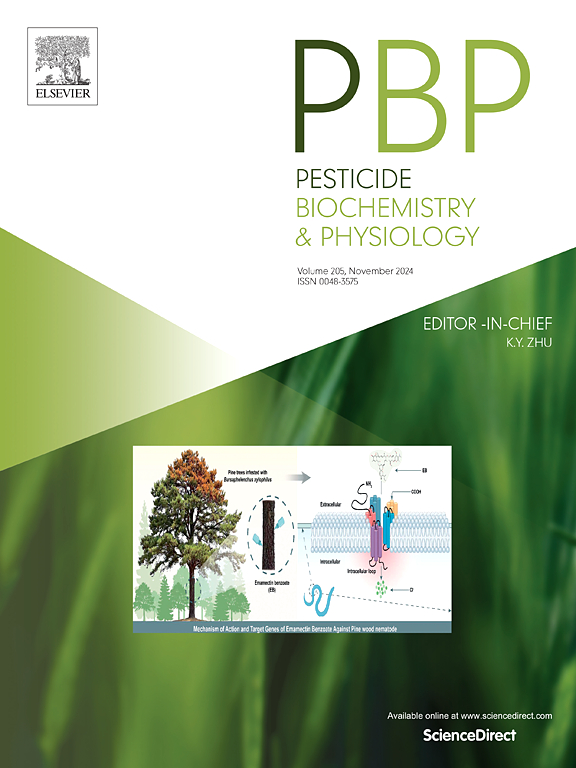草铵膦-铵通过微生物-肠-脑轴诱导中华绒螯蟹神经毒性机制的新认识
IF 4.2
1区 农林科学
Q2 BIOCHEMISTRY & MOLECULAR BIOLOGY
引用次数: 0
摘要
草铵膦(GLA)是一种高水溶性广谱除草剂,对水生生态系统中的水生生物具有潜在的危害。本研究从微生物-肠-脑轴角度评价GLA暴露对中华绒螯蟹幼鱼的神经毒性作用。急性毒性试验采用半静态法进行。结果表明,GLA暴露诱导了蟹幼体的神经毒性,主要表现为血清中神经元凋亡率、DNA损伤和神经元特异性烯醇化酶活性显著升高,且呈剂量依赖性。凋亡相关基因的表达也呈现出类似的趋势。此外,GLA暴露显著影响了蟹幼鱼神经系统的去极化和超极化信号转导过程。此外,与对照组相比,GLA暴露导致神经节代谢谱发生显著变化,尤其是氨基酸代谢和甘油磷脂代谢。暴露于GLA后,肠道微生物多样性在门、科、属水平上发生了显著变化。这些结果揭示了微生物-肠-脑轴在gla诱导的幼年蟹神经毒性中的潜在作用。综上所述,本研究提示GLA可能通过影响神经递质系统和神经信号转导引起幼蟹神经毒性损伤,甲壳类动物血脑屏障的不适用性可能加剧了微生物变化对神经功能的影响。本研究结果为GLA诱导神经毒性的机制提供了新的见解,并初步证明了GLA暴露于非靶水生物种的毒性风险。本文章由计算机程序翻译,如有差异,请以英文原文为准。

Novel insight into the mechanisms of neurotoxicity induced by glufosinate-ammonium via the microbiota-intestine-brain axis in Chinese mitten crab (Eriocheir sinensis)
Glufosinate-ammonium (GLA) is a highly water-soluble and broad-spectrum herbicide, which poses a potential risk to aquatic organisms in aquatic ecosystems. In this study, the neurotoxic effects of GLA exposure on juvenile Eriocheir sinensis were evaluated from the perspective of microbiota-intestine-brain axis. The acute toxicity test was conducted by semi-static method. The results showed that GLA exposure induced neurotoxicity in juvenile crabs, mainly manifested by significantly increased neuronal apoptosis rate, DNA damage and neuron-specific enolase activity in serum, and showed a dose-dependent manner. The expression of apoptosis-related genes showed a similar trend. Moreover, GLA exposure significantly affected the depolarization and hyperpolarization signal transduction processes in the nervous system of juvenile crabs. In addition, compared with the control group, GLA exposure resulted in significantly changed of metabolic profile in ganglia, especially amino acid metabolism and glycerophospholipid metabolism. The intestinal microbial diversity changed significantly at the phylum, family and genus levels exposed to GLA. These results revealed the potential role of microbiota-intestine-brain axis in GLA-induced neurotoxicity in juvenile crabs. Taken together, this study suggested that GLA may induce neurotoxicity damage in juvenile crabs by affecting the neurotransmitter system and nerve signal transduction, and the inapplicability of the blood-brain barrier in crustaceans may intense the effect of microbial changes on neurological function. The results of this study provide new insights into the mechanism of GLA-induced neurotoxicity and preliminarily demonstrate the toxic risk of GLA exposure to non-target aquatic species.
求助全文
通过发布文献求助,成功后即可免费获取论文全文。
去求助
来源期刊
CiteScore
7.00
自引率
8.50%
发文量
238
审稿时长
4.2 months
期刊介绍:
Pesticide Biochemistry and Physiology publishes original scientific articles pertaining to the mode of action of plant protection agents such as insecticides, fungicides, herbicides, and similar compounds, including nonlethal pest control agents, biosynthesis of pheromones, hormones, and plant resistance agents. Manuscripts may include a biochemical, physiological, or molecular study for an understanding of comparative toxicology or selective toxicity of both target and nontarget organisms. Particular interest will be given to studies on the molecular biology of pest control, toxicology, and pesticide resistance.
Research Areas Emphasized Include the Biochemistry and Physiology of:
• Comparative toxicity
• Mode of action
• Pathophysiology
• Plant growth regulators
• Resistance
• Other effects of pesticides on both parasites and hosts.

 求助内容:
求助内容: 应助结果提醒方式:
应助结果提醒方式:


